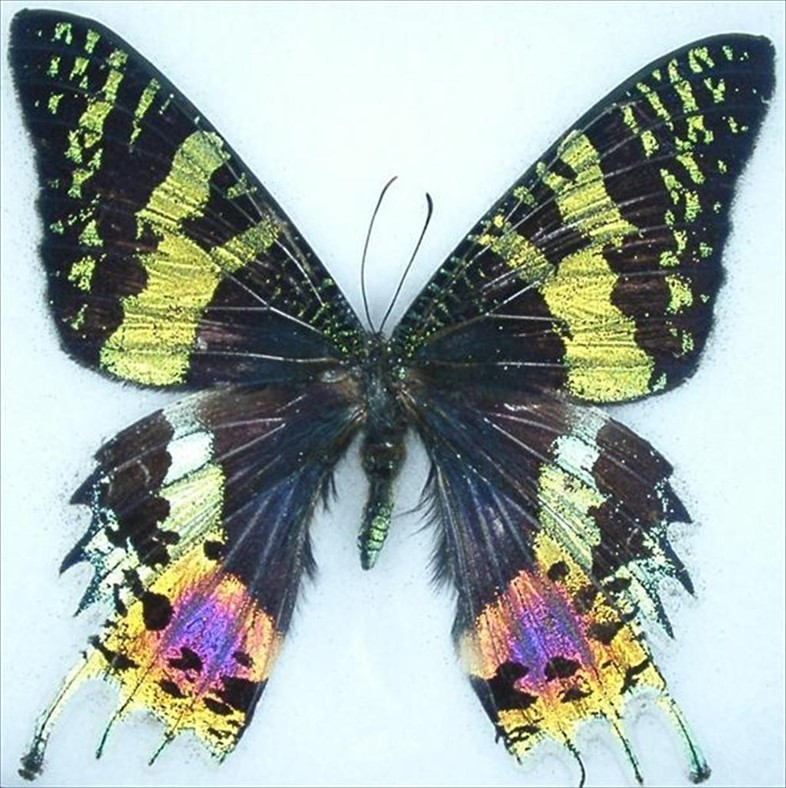The light-loving, clothes-eating pest is having its moment, as this week’s most Loved post on AnOther Loves is fashion accessory designer Gemma Land’s Urania ripheus – sunset moth. Far from the ugly, feathery antennaed, grey-winged insects we blast
The light-loving, clothes-eating pest is having its moment, as this week’s most Loved post on AnOther Loves is fashion accessory designer Gemma Land’s Urania ripheus – sunset moth. Far from the ugly, feathery antennaed, grey-winged insects we blast with repellent and aggressively swat on entering our homes at night, the day-flying Madagascan sunset moth is one of the most beautiful and impressive Lepidopteras bearing more of a similarity to its closely related butterfly. A member of the Uranlidae family, the sunset moth is known worldwide and is much sought after by collectors, rivalling almost any of the butterflies in brilliance of colouring and form. Vivid in appearance, the iridescent parts of its wings do not in fact carry any pigment; rather the colours originate from optical interference.
Whilst mottephobia is an irrational fear or hatred of moths, the study or watching of moths is known as “mothing” with someone who engages in the activity known as a “mother” or “moth-er”. Collected in the wild and raised commercially for the international butterfly trade; the sunset moth’s wings were used to make jewellery in the Victorian era. Today, you are more likely to find it mounted amongst a display of other entomology at places such as The Last Tuesday Society, which AnOther visited last Monday, or in a museum collection such as Museum Witt in Munich, which has the world's leading collection of moths. Here, we speak to Land about mothing and all things insect-related...
Why did you choose to Love this Urania ripheus – sunset moth?
A friend was telling me about the pastime of collecting moths, rearing them from caterpillars and seeing them transform from their cocoons. Once they have become moths they are then hand fed watery honey by uncurling their feeding tube with a needle.
If you owned this Urania ripheus – where would you put it and why?
Whilst it was alive I would keep it in an enclosure, otherwise I would have it box framed and keep it for inspiration.
Often hated for their clothes-eating habits – what is your view on moths?
As a child I was frightened of live moths, although this more had to do with leaving the light on in the dark than them eating clothes. I have always been fascinated with their intrinsic patterns and colour palettes. I feel I’m more drawn to moths now rather than butterflies due to the majority of them being nighttime creatures. Although the sunset moth is an exception to this as they are active during the day.
Are you a fan of entomology?
Yes, one of my favourite places to visit as a child was Wollaton Hall in Nottingham that has a beautiful Insects gallery; I used to spend many hours gazing at the different types of butterflies, moths and beetles.
What are your favourite insects and why?
Largely butterflies and moths, I am fascinated by the process of transformation they go through to have a fleeting moment of flight. I also love the metallic blues and greens that glitter on beetles.
As a fashion accessory designer have you created any insect inspired pieces and do you admire any from other designers?
I am currently researching for a possible future collection featuring butterflies, moths and beetles, and I greatly admire Alexander McQueen’s 2010 Spring/Summer collection that features the emerging butterfly in print.
What was the last thing you bought?
A blue wool mix vintage men’s coat.
What’s your favourite online shop?
Farfetch.com
Text by Lucia Davies
